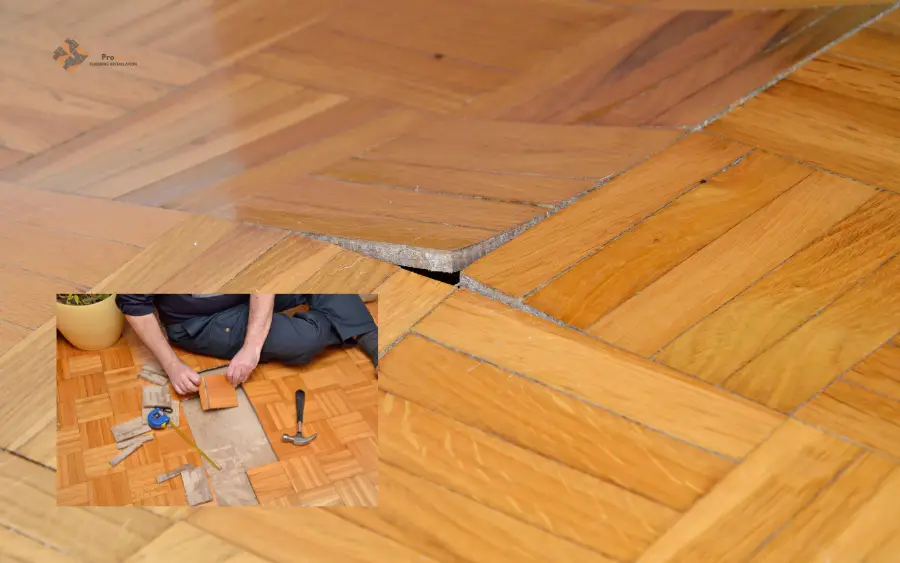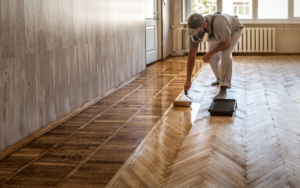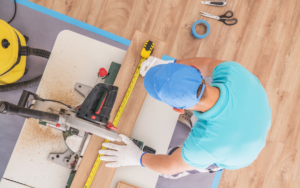Why Recognizing Floor Damage Early is Important
The Risks of Ignoring Floor Damage
Ignoring damage to your floor can lead to more severe issues, such as structural weakening and increased repair costs. Cracks, gaps, or warping can affect the stability of the flooring, which may result in more expensive repairs or even full floor replacements.
How Professional Floor Inspections Help
A professional floor inspection identifies the root causes of damage. Flooring experts assess not only surface issues but also underlying problems such as subfloor weaknesses or moisture damage, ensuring that the repairs are comprehensive and lasting.
Top 10 Signs Your Floor Needs Repair
1. Cracked or Broken Floorboards
Cracks in your floorboards can result from pressure, age, or environmental conditions. Over time, these cracks can expand, leading to splintering or further damage. Professionals use wood fillers or board replacements to repair these cracks, ensuring the floor’s integrity.
2. Visible Gaps Between Floorboards
Seasonal humidity changes can cause wooden floorboards to expand and contract, creating unsightly gaps. If these gaps become noticeable or persist, it’s a sign that repairs are needed. Flooring experts can apply gap fillers or realign the boards to close the gaps effectively.
3. Creaking or Squeaking Floors
Floors that creak or squeak are typically a sign of loose boards or issues with the subfloor. These noises may seem harmless, but they often indicate deeper structural problems. Professional repair methods include securing the boards with nails or screws and reinforcing the subfloor to eliminate the noise.
4. Water Damage
Water damage often manifests as stains, warping, or discolored patches on your floor. Prolonged exposure to moisture can rot wood, weaken the subfloor, and create an environment for mold. If water damage is detected early, professionals can replace damaged boards and seal the area to prevent future issues.
5. Floorboards Lifting or Warping
Floorboards that lift or warp often result from exposure to moisture or improper installation. Warping distorts the surface, creating uneven walking areas and potential tripping hazards. Repairing warped floors may involve replacing individual boards and addressing the moisture source.
6. Uneven or Sloping Floors
Uneven or sloping floors can signal problems with your subfloor or foundation. These issues can worsen over time, causing noticeable dips or slopes in your flooring. A professional can assess the root cause and apply leveling compounds or reinforce the structure to restore evenness.
7. Loose or Wobbly Tiles
Tiles that shift or feel loose underfoot should not be ignored. This may indicate improper installation or adhesive failure. Professional repairs involve re-securing the tiles with the correct materials, ensuring they stay in place and avoid potential damage to surrounding areas.
8. Soft Spots or Sagging in Floors
Soft spots in your floor often result from subfloor damage or water infiltration. These areas can sag or feel spongy when walked on, indicating compromised structural integrity. Flooring professionals replace the damaged subfloor sections and reinforce the area to prevent further sagging.
9. Persistent Stains or Discoloration
Stains on your flooring may go beyond the surface, penetrating deeper into the material and becoming difficult to remove. In some cases, refinishing can restore the floor’s appearance, but persistent discoloration may require professional sanding and sealing or board replacement.
10. Musty Odors from Flooring
Musty smells often signal mold or mildew growth beneath the surface, typically due to moisture buildup. Professionals can address the underlying moisture issue, replace affected areas, and apply treatments to prevent mold growth.
The Benefits of Professional Floor Repair
Why DIY Fixes Often Fall Short
DIY floor repairs may seem cost-effective but often lead to temporary fixes that fail to address the underlying issues. Inadequate repairs can worsen the problem, resulting in higher costs down the line. Simple gaps, creaks, or warping may need professional attention to ensure lasting results.
How Professionals Ensure Lasting Repairs
Flooring experts use specialized tools and materials designed for specific flooring types. They apply professional techniques that not only repair visible damage but also prevent future issues, ensuring a long-term solution that adds value to your home.
Compare DIY vs Professional Services
Risks of DIY Floor Repairs
DIY repairs can lead to uneven flooring, improper materials use, and inadequate fixes for deeper issues like moisture damage. These common mistakes often require professional correction, resulting in higher costs in the long term.
Advantages of Professional Floor Repair
Flooring professionals bring experience and expertise, ensuring that the correct repair methods are used. They can identify problems that might go unnoticed by homeowners, such as subfloor damage or hidden moisture, and provide durable solutions that extend the life of your floor.
Benefits of Consulting with Flooring Experts
FAQ
Visible cracks, gaps, or water damage are signs your floor may need repair. A professional inspection can determine if a repair or replacement is necessary.
Minor squeaks can sometimes be fixed with simple methods like securing loose boards, but a professional can ensure the squeaks don’t return.
It depends on the extent of the damage, but most floor repairs can be completed in a few days. A professional can give you a more accurate estimate based on your specific situation.
Yes, well-maintained and professionally repaired floors can improve both the appearance and value of your home, making it more appealing to potential buyers.
Address water damage immediately by calling a flooring expert. Quick action can prevent further damage and save you from more expensive repairs.





